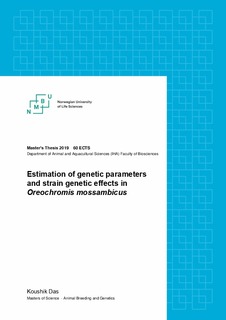| dc.description.abstract | A breeding program for Oreochromis mossambicus has been established by CEPAQ (Centro de Pesquisa em Aquacultura, translated as The Research Centre in Aquaculture) and is intended to develop the local fish farming industries in Mozambique. As much of the area do have high salinity, O. mossambicus is considered suitable for cultivation as they have the capacity to grow even in high estuarine condition. To genetically improve and produce quality fingerlings of O. mossambicus, the base population was created by using the best performing pure strain and strain combination as parents in the breeding program.
The aim of this study was thus to estimate genetic parameters in three strains of Mozambique tilapia (Oreochromis mossambicus), this includes the degree of strain additive, reciprocal and heterosis effects for different traits. A partial factorial mating design with reciprocal crosses and parentage assignment using Genotype-By-Sequencing (GBS) data were used to estimate the proportional effect of additive (h2 ) dominance (d2 ) and maternal effects (m2 ) for six different traits in Mozambique Tilapia. The study includes observations of 1119 individuals from 300 fullsib families. Two different nested statistical models, an Additive-Dominance-Maternal (ADM) model and a Sir-Fullsib-Maternal (SFM) model, including their reduced variants, were used to test the significance of each effect in the full model.
The estimates of heritability reported by the ADM models and SFM models were almost similar for most traits; e.g. the heritability of Harvest Body Weight (HBW) for the ADM model and SFM model were 0.13 and 0.14 respectively. A large amount of dominance was observed for some of the traits, e.g. it was 0.45 for harvest body weight when using the SFM model.
A separate general linear mixed model was also used to describe the strain additive, reciprocal and heterosis effects for each trait. For harvest body weight, crossing between S2 and S3 strain yielded positive heterosis effect. The reciprocal effects were non-significant for all the crosses and the additive strain effect was only significant for the S1 strain. Crossing S2 and S3 strain seems to be the best way forward to improve the breeding population, either by a pure-breeding or a crossbreeding scheme. | nb_NO |

